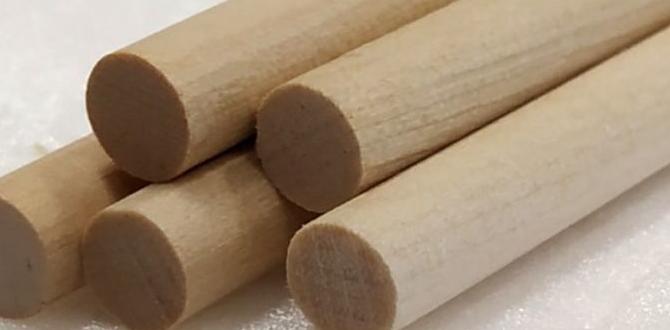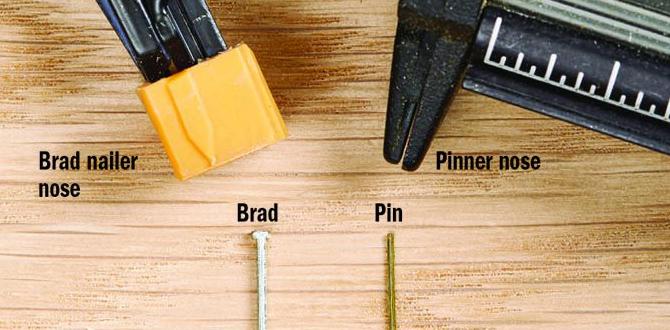Don’t let crooked nails ruin your DIY projects! This guide shows you exactly how to fix them with simple techniques and the right tools, ensuring a professional finish every time. Get ready to nail it!
So, you’re in the middle of a woodworking project, feeling that DIY pride, and then it happens – a crooked nail. It’s a stubborn little issue that can throw off the look of your work and make you question your skills. But trust me, even seasoned pros run into this sometimes! The good news is, fixing crooked nails from a nail gun isn’t rocket science. It’s all about understanding why it happens and having a few straightforward methods up your sleeve.
In this guide, we’ll walk through the common reasons nails go astray and, more importantly, how to correct them. We’ll cover everything from gentle nudges to more involved fixes, all explained in a way that’s easy to follow. Get ready to transform those frustrating moments into satisfying successes. Let’s dive into making your projects look their absolute best!
Table of Contents
What Causes Nails to Go Crooked?
Understanding the root cause is the first step to fixing the problem. A nail can go crooked for a few different reasons, often related to how it enters the wood or the wood itself.
Nail Gun Angle
This is probably the most common culprit. If your nail gun isn’t held perfectly perpendicular (straight up and down) to the surface of the wood, the nail will naturally be driven in at an angle. Even a slight tilt can cause the nail to veer off course, especially if it hits a knot or a harder grain pattern.
Wood Density and Grain
Wood isn’t perfectly uniform. Some areas are denser than others, and the grain direction can change. When a nail encounters a particularly hard spot, a knot, or travels against the grain, it can deflect sideways, leading to a bowed nail. It’s like trying to push a needle through different layers of fabric; some will be easier than others.
Improper Nail Placement
If you’re too close to the edge or corner of a piece of wood, there’s less material to support the nail. This can cause the wood to split or the nail to bend and exit at an angle. The thinner the wood, the higher the risk.
Nail Gun Settings and Performance
Your nail gun needs to be set up correctly. If the air pressure is too low, the nail might not have enough fuerza to drive straight, especially into denser wood. Conversely, too much power can sometimes cause excessive recoil, which can jolt the gun off-angle as it fires. Also, ensuring the magazine is properly loaded and feeding nails smoothly is key; a jammed or misfed nail can cause issues.
Nail Quality
While less common with quality tools, sometimes the nails themselves can be slightly bent or have imperfections in their shaft or tip. This can guide them off course right from the start.
How to Fix a Crooked Nail
Don’t worry, a crooked nail isn’t the end of the world! There are several ways to deal with them, depending on how much of the nail is showing and how badly it’s angled.
The Gentle Nudge Method (For Partially Driven Nails)
If you catch the nail really early, as it’s just starting to go in crooked:
- Stop Firing: Immediately release the trigger.
- Adjust Angle: Gently try to push or adjust the angle of the nailer to straighten the nail as it’s being driven. This often requires a very light touch and might only work if the nail is just beginning to bend.
- Re-engage: Lightly squeeze the trigger again to try and drive it fully straight. This can be tricky and might not always work perfectly, but it’s worth a try for minor bends.
The Hammer and Pliers Technique (For Slightly Crooked Nails)
This is a classic and often effective method for nails that have gone in most of the way but are visibly crooked.
- Gather Tools: You’ll need a hammer and a sturdy pair of pliers (locking pliers like Vise-Grips work exceptionally well here).
- Grip the Nail: Use the pliers to get a firm grip on the head of the nail. If the nail head is countersunk or damaged, the locking pliers can still get a good purchase on the shaft just above the wood.
- Gentle Leverage: Apply gentle, steady pressure with the pliers in the direction you want the nail to bend. Think of it as guiding, not forcing. You’re trying to coax the nail back into a straighter path.
- Tap with Hammer: You can also use the hammer’s claw or the side of the hammerhead to gently tap the nail back into place. Be careful not to mar the wood surface. Place the pliers as close to the nail head as possible to give you the best leverage while protecting the wood.
- Countersink Again: Once straighter, you might need to use the nail gun again (carefully!) or tap with a nail set and hammer to drive the head flush or slightly below the surface.
Tip: For very stubborn nails or when you need to apply more controlled force without damaging the wood, place a thin piece of scrap wood or cardboard between the pliers and the surface of your project. This acts as a buffer.
The Nail Puller or Cat’s Paw Method (For Severely Crooked or Driven Nails)
If a nail is completely bent off course or driven in too far at an angle, you might need to remove it entirely.
- Choose Your Tool: A standard nail puller (often part of a claw hammer) or a specialized tool like a cat’s paw (a pry bar with a sharpened claw) is best. A cat’s paw is designed to dig under nail heads that are flush or countersunk.
- Position the Tool:
- Nail Puller: Slide the claw under the nail head. If the head is flush or gone, you may need to carefully use a chisel or a sharp utility knife to create a small notch in the wood around the nail head so the puller can get a grip.
- Cat’s Paw: Drive the sharpened claw of the cat’s paw under the nail head with a hammer.
- Apply Gentle Leverage: Like with the pliers, use steady, controlled force. Rock the tool back away from the nail to lift it out. Again, using a scrap piece of wood under the fulcrum point of the tool will protect your workpiece from dents and gouges.
- Fill the Hole: Once the nail is removed, you’ll have a hole. For structural integrity and appearance, you’ll want to fill this. Wood filler or a dowel can be used. If the hole is small and not structural, wood putty will do.
- Re-nail or Repair: After the filler sets, you can drill a new pilot hole and carefully drive a new nail nearby, or proceed with your project if the hole is no longer an issue.
Safety First: Always wear safety glasses when prying nails. Wood can splinter, and nails can unexpectedly pop out.
The Countersink and Fill Method (For Minor Imperfections)
Sometimes, a nail is just slightly off, and pulling it seems like overkill. If the nail head is slightly proud of the surface or just a hair off angle:
- Use a Nail Set: Place a nail set on the head of the crooked nail.
- Tap Gently with Hammer: Tap the end of the nail set with a hammer to drive the nail head further into the wood. Be very careful to keep the nail set perfectly vertical to avoid further bending the nail or making a bigger mess.
- Assess: If the nail is now flush or slightly countersunk, you can often get away with a bit of wood filler or putty to hide the imperfection. If it’s still noticeably crooked but the head is set, you might consider filling it even if it’s not perfectly straight, as long as it no longer interferes with your project.
When to Use This: This is best for situations where the crookedness doesn’t affect the structural integrity or the final visual outcome too drastically, or when you plan to paint or heavily finish the piece.
Preventing Crooked Nails Going Forward
An ounce of prevention is worth a pound of cure, right? Here are some tips to minimize crooked nails from your nail gun right from the start:
Maintain Proper Angle
Always hold your nail gun perpendicular to the surface of the wood. Imagine you’re drawing a straight line with the nail; the gun needs to be on that line. Use a rocking motion to ensure contact, but keep the gun body straight.
Adjust Nail Gun Settings
Make sure your air pressure is set correctly according to your nail gun’s manual and the type of wood you’re using. Too little pressure can lead to weak drives and crooked nails, especially in hard woods. For a general guide, most framing jobs use around 90-120 PSI, while finish nailing might be lower, around 70-90 PSI. It’s always best to check the National Institute for Occupational Safety and Health (NIOSH) recommendations for nail gun safety and usage, which includes proper pressure settings.
Two-Handed Grip and Stabilization
Use both hands to operate the nail gun whenever possible. One hand on the grip and trigger, and the other to stabilize the body of the gun. Pressing the gun firmly against the wood surface helps minimize recoil and keeps it steady.
Consider the Wood Edges
When nailing close to the edge of a board, especially thinner stock, there’s a higher chance of splitting or deflection. Try to drive nails closer to the center of the board or consider pre-drilling pilot holes in critical areas if you consistently face issues with splitting.
Use Quality Nails
Stick to high-quality nails from reputable brands. Cheap or inconsistently manufactured nails can have slight bends or imperfections from the factory that lead them to shoot crooked.
Clean and Maintain Your Gun
A well-maintained nail gun performs better. Ensure the magazine feeds smoothly and that there are no obstructions. Regular cleaning and lubrication, as per the manufacturer’s instructions, can prevent many operational hiccups.
Comparison of Fixing Methods
Let’s break down the different fixing methods to help you choose the best one for your situation.
| Method | Best For | Pros | Cons | Tools Needed |
|---|---|---|---|---|
| Gentle Nudge | Nails just starting to bend | Quick, minimal damage | Only works on very early bends, requires finesse | Nail gun |
| Hammer & Pliers | Slightly crooked, partially driven nails | Often effective, good control, minimal damage to wood face | Can be difficult if nail head is badly damaged or countersunk | Hammer, Pliers (locking recommended) |
| Nail Puller/Cat’s Paw | Severely crooked, fully driven, or flush nails | Removes nail completely for fresh start, effective for stubborn nails | Leaves a hole to fill, potential for minor wood damage around hole | Nail Puller or Cat’s Paw, Hammer (for cat’s paw), may need chisel |
| Countersink & Fill | Minor imperfections, slightly bent heads | Hides minor issues, fast, no nail removal required | Doesn’t fix the crookedness, can look imperfect if not done well | Nail Set, Hammer, Wood Filler/Putty |
FAQs About Fixing Crooked Nails
Q: What is the fastest way to fix a crooked nail?
A: If the nail is just slightly embedded and crooked, the fastest way is often the “Gentle Nudge” if you catch it immediately. If it’s already driven in a bit, the Hammer and Pliers technique is usually the quickest for minor bends without removing the nail, followed by a quick set/fill.
Q: Can I just leave a slightly crooked nail?
A: It depends on the project. If it’s a hidden structural piece and the nail is holding firm, you might be able to leave it. However, for visible projects, especially those that will be painted or stained, a crooked nail can telegraph through the finish. It’s usually best to fix or remove it for a clean look.
Q: What if the nail splits the wood when it goes in crooked?
A: If the split is minor, you might be able to carefully drive the nail to hold the wood together and then fill the split with wood glue and sawdust (or a matching wood filler) once the glue dries. For larger splits, it might be necessary to remove the nail and repair the wood before attempting to re-nail.
Q: How hard should I hammer or pry when fixing a crooked nail?
A: Always use controlled force. You want to be firm but not brute force. Too much force can break the nail, damage the wood, or cause further issues. Gentle, consistent pressure or taps are usually more effective than strong blows.
Q: When is it better to remove the nail completely?
A: It’s better to remove the nail if it’s severely bent, sticking out at a dangerous angle, has caused significant wood splitting, or if its crookedness will be highly visible and cannot be corrected by simple bending or filling.
Q: Will my nail gun be damaged if I try to fix a crooked nail?
A: Generally, no. Trying to correct a crooked nail involves using hand tools or carefully re-firing the gun for a very short burst. This won’t damage the nail gun itself. The main risk is to your workpiece if you’re not careful with your tools.
Conclusion
Dealing with crooked nails might seem like a setback in your DIY journey, but as we’ve seen, it’s a common hiccup that’s entirely manageable. Whether you’re using a gentle nudge, the trusty hammer-and-pliers combo, or a more robust nail puller, you now have a clear arsenal of techniques to correct those wayward fasteners. Remember, the key is to diagnose the cause—be it an angled gun, tricky wood grain, or a setting issue—and then apply the right fix with patience and control.
By incorporating these methods into your woodworking toolkit, you’ll not only salvage projects that might have otherwise been frustrating but also develop a keener eye for preventing these issues in the first place. Keep practicing those proper angles, check your nail gun settings, and don’t hesitate to use a little extra support when needed. Each project is a learning opportunity, and mastering the art of fixing crooked nails is a sure sign of a dedicated and capable DIYer. So, pick up your tools with confidence, knowing you’ve got this! Happy building!



